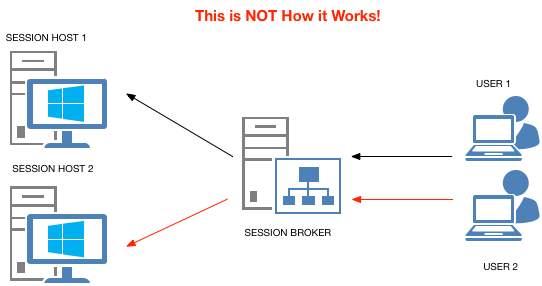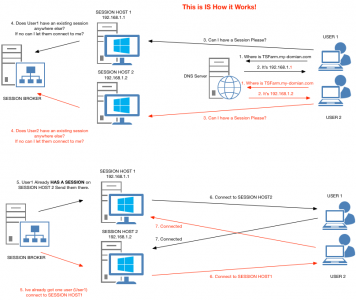KB ID 0001424
Problem
I got an email from a colleague who was setting up an RDS farm, (2012 R2). He was having some problems and asked me; “If the Connection Broker brokers the connections to the Session Hosts, how do I RDP to the Session Broker?”
This threw me completely, I usually jump on the console in VMware or use a third party remote management tool, I don’t tend to to RDP onto servers. I had fallen into the same trap he had. I assumed: You connect to a SESSION BROKER and it BROKERS YOUR SESSION to the least busy session host, (or reconnects your broken sessions).
THIS IS WRONG!
How Session Brokers Work
You don’t connect to a session broker, (unless you are an admin who is about to do some work on the Session Broker). You connect to a DNS RECORD, and that record points to a SESSION HOST, (I know that makes no sense, but bear with me). And you create a DNS record with the SAME NAME for every Session Host like so,
This works because, (by default) Windows DNS uses ’round robin’ so if it has multiple values for one DNS name is responds with the first one to the first request, the second one to the second etc.
But Pete? Round Robin is Bobbins for Load Balancing? Yes it is, that’s what the Session Broker is for! In reality this is what happens;
This is two scenarios that should clear things up, User1 queries DNS for TSFarm.my-domain.com and gets an IP of 192.168.1.1, They go to that SESSION HOST, the the session host CHECKS WITH THE CONNECTION BROKER, firstly to see if User1 already has a session on another session host, if so they are reconnected to that session, above that’s on SESSION HOST 2.
Then User2 attempts to connect toTSFarm.my-domain.com and gets an IP of 192.168.1.2 (Because of DNS ’round-robin’). They go to that SESSION HOST, then the session host CHECKS WITH THE CONNECTION BROKER, firstly to see if User2 already has a session on another session host, in this case they don’t. But, this host already has User1 connected to it, so it redirects User2 onto SESSION HOST 1.
Of course a user can connect to a SESSION HOST and after checking with the the CONNECTION BROKER they get connected to the host they originally queried if, (for example) the other session hosts are busier, (and the user has no existing sessions.)
But With Server 2012 You Can Do Connection Broker Load Balancing? Yes, you can, but that’s load balancing for the connection brokers, NOT the user sessions!
Related Articles, References, Credits, or External Links
Thanks to James White for making me do some work!



